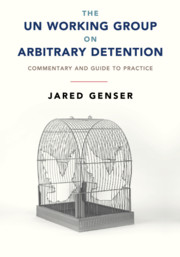Book contents
- The UN Working Group on Arbitrary Detention
- Reviews and Endorsements for The UN Working Group on Arbitrary Detention:
- The UN Working Group on Arbitrary Detention
- Copyright page
- Contents
- Figures
- About the Author
- Foreword
- Acknowledgments
- Abbreviations
- Part I. Background
- Part II. Individual Case Procedure
- Part III. Case Jurisprudence
- Part IV. Additional Case Studies
- 10 Mohamed Nasheed v. The Maldives
- 11 “Balyoz” or Sledgehammer Cases v. Turkey
- 12 Aung San Suu Kyi v. Myanmar
- 13 Mukhtar Ablyazov v. France
- 14 Yang Jianli v. China
- Table of Authorities
- Required Legal Materials
- Index
12 - Aung San Suu Kyi v. Myanmar
from Part IV. - Additional Case Studies
Published online by Cambridge University Press: 20 September 2019
- The UN Working Group on Arbitrary Detention
- Reviews and Endorsements for The UN Working Group on Arbitrary Detention:
- The UN Working Group on Arbitrary Detention
- Copyright page
- Contents
- Figures
- About the Author
- Foreword
- Acknowledgments
- Abbreviations
- Part I. Background
- Part II. Individual Case Procedure
- Part III. Case Jurisprudence
- Part IV. Additional Case Studies
- 10 Mohamed Nasheed v. The Maldives
- 11 “Balyoz” or Sledgehammer Cases v. Turkey
- 12 Aung San Suu Kyi v. Myanmar
- 13 Mukhtar Ablyazov v. France
- 14 Yang Jianli v. China
- Table of Authorities
- Required Legal Materials
- Index
Summary
Imprisoned under house arrest for fifteen years over a twenty-one-year period, from 1989 to 2010, the Burmese pro-democracy leader and human rights activist Aung San Suu Kyi became one of the world’s most prominent political prisoners and the face of the Myanmar opposition movement. In 1991, she was awarded the Nobel Peace “for her non-violent struggle for democracy and human rights.”1 Over the course of her imprisonment, Aung San Suu Kyi was the subject of six WGAD opinions. The author was hired by her family to serve as her international counsel from mid-2006 until her release on November 13, 2010. He worked with Aung San Suu Kyi’s local counsel, U Nyan Win and U Kyi Win, along with countless others globally, to utilize the latter three opinions, in combination with political and public relations advocacy efforts, to advance efforts to secure her freedom and that of other political prisoners from the military junta. Under house arrest, Aung San Suu Kyi was denied access to virtually everyone from the outside world other than her doctor, domestic lawyer, occasional diplomat friendly to the military junta, and Liaison Minister for the then-junta U Aung Kyi.
- Type
- Chapter
- Information
- The UN Working Group on Arbitrary DetentionCommentary and Guide to Practice, pp. 512 - 530Publisher: Cambridge University PressPrint publication year: 2019



